Transparency and honesty are always at the forefront of our activity. These two are the bedrock for all the interactions we have with our customers (both actual and upcoming). This means we are constantly exposing ourselves to their feedback, assuming our mistakes publicly, facing reality, no matter how honeyed or harsh. Their lessons have always helped us improve our products and services.
This article is a collective effort of George and Oana. We aim to provide as much value as possible by combining our particular perspectives toward customer reviews.
Here’s what we’re going to cover in this article:
- Customer testimonials, reviews, feedback: what’s the difference?
- How to ask for reviews to get the right response
- The process of displaying customer reviews
- Ground rules for a review system
These past years, we’ve tried many ways to get feedback about our customers’ experience. We went from using the standard 5-stars model to encourage them to write public reviews on social media. We switched from measuring the success rate of our customer support conversations to running video calls and even meeting with them in real life.
Each one of these actions was valuable in its own way — definitely better than none. However, through constant iteration, we are confident we reached a nice balance between the effort needed to ask for reviews and the quality of the input we receive.
Today, we’ve managed to elevate the dialogue and transparency toward our customers to a brand new level. We created a review system that does not allow us to cheat in any way — at least not without being caught. It is public, contextual, and unfiltered — we don’t shy away from those 1-star reviews. In other words, it’s our genuine way to show how much we care about our customers’ insights. Only by actively listening can we continue to do meaningful work.
Knowing the risks from the start, and committing to them, shaves off the “illusion of perfection” and it will only set the right expectations for the experience to come.
What’s the cost of all this effort? Well, the answer is straightforward and in alignment with our values. We are eager to climb a steep learning curve and grow. We are far from the whatever-works kind of attitude.
Therefore, such forthright reviews act as a vector of force, which pushes us steadily to do better work. Customer feedback has often proved a goldmine of insights and, without it, our products wouldn’t be where they are today — gracefully competing in a global market.
Customer testimonials, reviews, feedback: what’s the difference?
With every endeavor that we encounter in life, we need to find a way to balance how we imagine things are and how they are in reality. For that purpose, getting feedback on your work, be it a service or a product, is paramount to constantly improving your work and making sure you’re still on the road to your desired destination.
In the context of “user feedback,” you might have heard various terms that sit under the same umbrella: customer interviews, user surveys, live chat, ratings, reviews, testimonials, user testing, on-site activity analytics.
While we tested most of them, in this article we’re going to cover the “review systems”: what they are, how they work, when and how to ask for reviews.
What is a review system?
A review system is a method for empowering your customers to share their opinions and experiences about your product or service while organizing and displaying the end result publicly. By leveraging this content, you will be able to improve your product, increase sales, and build trust in your brand.
The term “review” is often mixed and confused with “testimonial.” That’s why we find it useful to make a short detour and share my input – it’s important for the rest of this article to have a common understanding of the term.
From testimonials to reviews
We think testimonials showcase how some users (not all) make good use of the value provided by a service or a product. They emphasize that value proposition and employ an external perspective (with a face) to back them up.
Testimonials are helpful to read, portray a feeling of reality, and are mostly enthusiastic, short, efficient, cherry-picked, and widely used as marketing tools due to their entanglement with your emotions.
I’m not saying that they are false. No, they should be true — just expect them to focus exclusively on the good sides of what you will get. There are always flaws, hopefully negligible, and nasty sides that you want to know beforehand. For this, enter the reviews.
Reviews deliver the customer’s whole perspective: both the good and the bad, the macro and the micro, the beauty, and the beast. They are not only about rephrasing your product’s strongest points but also about showing weaker sides that a future client should understand and take into consideration when making the decision.
Albeit counter-intuitive, that’s helpful both for you and your prospective customer: knowing the risks from the start, and committing to them, shaves off the “illusion of perfection” and it will only set the right expectations for the experience to come. Thus, both parties start on the right footing, more likely to build a long and fruitful collaboration.
We are inherently flawed and broken beings. Perfection is beyond us. […] No one is normal: the only people we can think of as normal are those we don’t yet know very well.
Accepting Imperfections (The School of Life)
It’s invaluable to have a wide range of review types, varying from the so-called “bad” 1-star reviews to the “ideal” 5-stars ones, each accompanied by valid reasons and genuine feelings. This heterogeneous group of opinions will help you portray an authentic reality in front of your viewers, build trust and relatedness; we are all inherently flawed up to a certain level, but only a few of us dare to accept it publicly.
How to ask for reviews to get the right response?
You might be accustomed to the dynamics of getting feedback in person. Regardless if it’s after a public presentation or after writing a long-form article, you usually ask a straightforward question such as “How did my performance make you feel?” or “What did you like the most?”
The person answering will share his thoughts, good, bad, most often, a mix between the two, you thank them for taking the time to provide it, and move on, hopefully, thinking about what you can do better next time. At least that’s the core intention.
It’s easier for us to do this in person since we were exposed to it early on in our school days when teachers and colleagues regularly shared their feedback with us, besides grades. Once we make the switch to the digital world, we often shave off a few layers from this conversation and stick to “How many stars do I get for my performance” and “If you think so, please provide some details about this.” The difference between the two is that in-person, you get real insights and look for profound thoughts, but online, on the other hand, you’re barely scratching the surface.
It’s somehow funny to see how many people are missing opportunities that are common sense in a real-life context.
We need to learn to bring more behaviors from the offline world in the crazy digital environment. At the same time, we should get rid of all kinds of shortcuts that we all-too-eagerly internalize due to technology, instant-gratification meter, and lack of accountability. We can do a better job!
Before giving you a helping hand and walking you through what you should ask your customers, here is a glimpse of the actual user story we had in mind when we designed our latest review system:

User story
- Before purchasing one of our products, our prospective customer has a set of “needs,” among which “trust” is one of the most valuable currencies.
- The customer reads through reviews to find potential drawbacks that he’s willing to take on: risks. To help uncover those risks, we will:
- Help current customers talk more about their experience and what they managed to achieve through our products (not about the product itself).
- Ask questions to capture meta-data about the reviewer (e.g., ratings based on various attributes like “Ease of use” or “Value for money“), so their review will be transparent for other users.
Let’s dig deeper and see what to ask for in a review. Although most of the guidelines are suitable for all kinds of businesses, what follows is tailored to our needs, so feel free to question our approach and take whatever fits your scenario.
What to ask for in a review?
Think about the kind of feedback persons in a couple give one another, constantly. This type of “reviews” helps uncover areas where both partners need to work on and improve. With honest and cordial communication, they can have a fulfilled, happy, and balanced relationship. The more specific you are when you share your thoughts with your loved one, the better.
In the end, you take part in such a commitment not because the other one helps with chores around the house, but mainly because only by having this healthy bond you can fulfill needs like having a family, a home, a strong feeling of belongingness.
When it comes to businesses, bear in mind that you need to get exhaustive reviews from different perspectives. To achieve this level of engagement, you need to give them the right instructions and enough space to express what’s on their mind.
Asking for their “name” and an “overall rating” is only the baseline from where you should start.
And instead of having an empty “comments” field, why wouldn’t you make use of an open-ended question? Additionally, you can add further instructions, set the right expectations, and walk the user through what you’re looking for. Here is an example of how we do it:

How would you describe the overall experience of being our customer and working with our products?
This is where you can go in-depth and freely express your thoughts about what you liked or disliked about us and our products. Your remarks are a goldmine because they help other people decide whether to use a product from Pixelgrade.
We know that a bit of guidance helps, so here are a few questions to walk you through:
1. What specifically made you buy this product?
2. Which downsides come first to your mind?
3. How would you describe us to a friend?
You might be prone to think that’s enough, and it could be if you’re just starting out or want to settle for less. Both are okay as long as you are satisfied. At Pixelgrade, excellence is one of our core values, and that’s why we always go a step further (or a few more), so let’s move the needle together.
By going a bit more in-depth, you can help potential buyers better relate to those reviews by providing more specific details about the person that already purchased from you.
We’ve split our reviews into subcategories, thus reaching two goals in one fell swoop:
- Help visitors relate more with previous customers and their particular experience and
- We gain an in-depth understanding of our users and use that to make decisions.
Below are a few attributes we measure to learn more about customers and their experience with us:
- Level of experience: there is a difference between a 5-stars review from someone new to the industry and a 5-stars review from someone that tried hundreds of similar products or services over the years, with plenty of domain-specific knowledge and experience worth sharing.
- Ease of use: understand if they figured out how the product works by themselves, or if they needed an entire army to come to the rescue.
- Value for money: shows if it paid off to spend their money on our product or service.
- Customizations: measures if the level of flexibility is sufficient for their needs and if they had creative freedom.
- Help and Support: gauges if the assistance received was gratifying or left the impression that nobody hears them.
The information is collected within a five-level Likert-type scale. The ends of the range can be from Simple to Complicated or from Poor to Great. We strongly suggest you use the same five-level scale, mark the range endpoints clearly, and you should be safe.
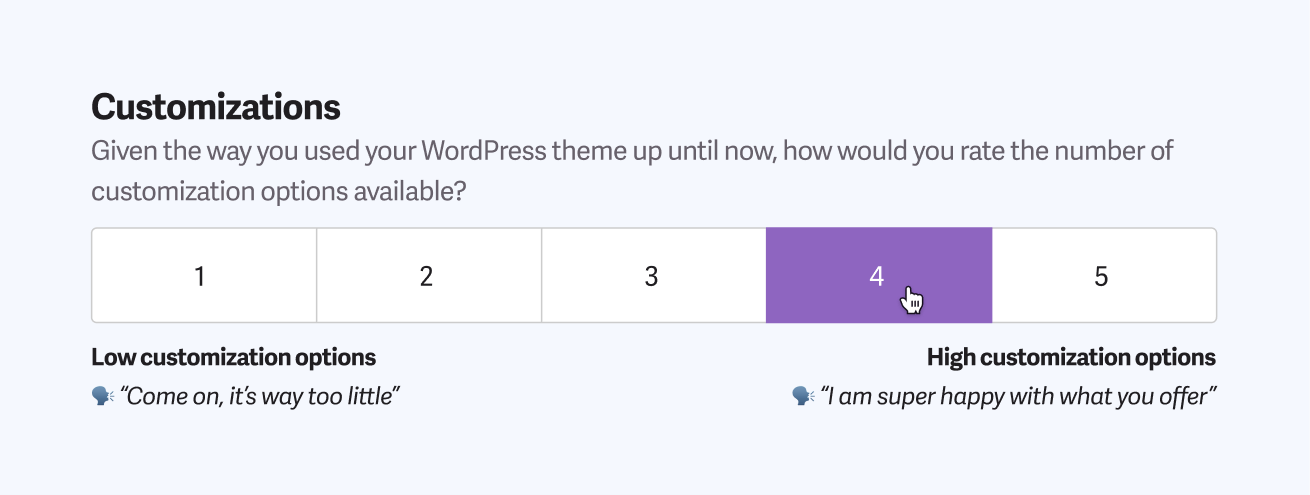
A few ways to get reviews from your customers
1. Manually using the classic email
Before investing in a complex system that requires time and energy, I suggest you start gathering reviews using an agile and clean tactic: sending emails. It’s the most convenient way to collect the same level of information. It also feels very natural for customers.
On top of that, email comes with a huge benefit: it is a separate environment that is focused on one thing: your message. People can take their time to reply instead of hurrying up to tap that “Publish” button as they’ve been trained to do on social media.
Therefore, at this stage, the system is not important. Your focus should be on writing down the right questions rather than building a grand cathedral. Craft questions that offer your customers a way to express their input without trying to lead them to a pre-defined answer. Avoid closed ones a.k.a. those where the receiver is encouraged to answer monosyllabic, often with a ‘’yes’’ or ‘’no.’’
It’s wiser to leave them enough room to share all kinds of details and write in-depth than cutting it short. Questions matter quite a lot, so make sure you pay attention to them. Don’t overdo it because you have the chance to iterate along the way and improve on them.
Just throwing the questions in an email is not enough though. It’s like seeing if the spaghetti will stick to the wall. You should take responsibility and follow-up with your customers. If they did not answer, maybe they did not have the time. Or maybe they missed your email. Or perhaps they did not understand what you want from them. Try to find out instead of assuming they don’t care to answer.
At the same time, just like in a relationship, avoid being needy and asking for a lot of attention, energy, or validation. Give a friendly reminder, reinforce why they should contribute, and take it from there.
This way, you act like an adult who is in charge of his emotions, not like a kid who constantly needs all kinds of reassurances: intellectual, emotional, and so on.
2. Semi-automatically with the help of online tools
In case you need to speed up the process and automize parts of it, you can always choose from the available options out there. Google Forms or Typeform are two of the tools that can help you get the job done. Both are easy to use, come with specific analytics, allow you to download the results and take a closer look.
At some point, we used them too, and they were perfect when we needed to ask for reviews from our customers. We combined Google Forms with a bit of manual work to mark who answered our email, who didn’t, when we should follow-up, and with whom. It can be done, trust us.
It’s far better to start encouraging your customers to write down reviews about your products and services than to wait for the polished version of an entire system. If today you do not know about the people who are spending their money on your offering, don’t postpone it anymore and put together an online form.
People who do not answer due to the way or shape the question came through might not be relevant for the community you want to build around your brand. If their major blocker to share their review is the UX of a tool, well, maybe they are not interested. It’s okay, move on. No business out there gets 100% response rate anyway.
3. Automatically by building a custom system
Now, if you feel you reached a point where you want to take the leap and leverage your relationship with your customers, you can start thinking about a custom system. It could be the cherry on top. Bare in mind that you need reliable resources for that, but who knows, maybe the way we did it ourselves turns out to be scalable and accessible for you too.
Throughout our history, we used to manually send six questions to each client, centralize the answers in a document, and publish them manually onto our site.
We wanted to take this process to a new level, and, since we were confident enough that we can automate part of it, we developed a multi-step review process fully integrated into our website. We also make sure to answer each review publicly in an attempt to keep everything transparent. From time-to-time, we still send feedback requests via email because we want to keep the dialogue alive and kicking.
Below are the four steps that we use to guide the customers in the review writing process:
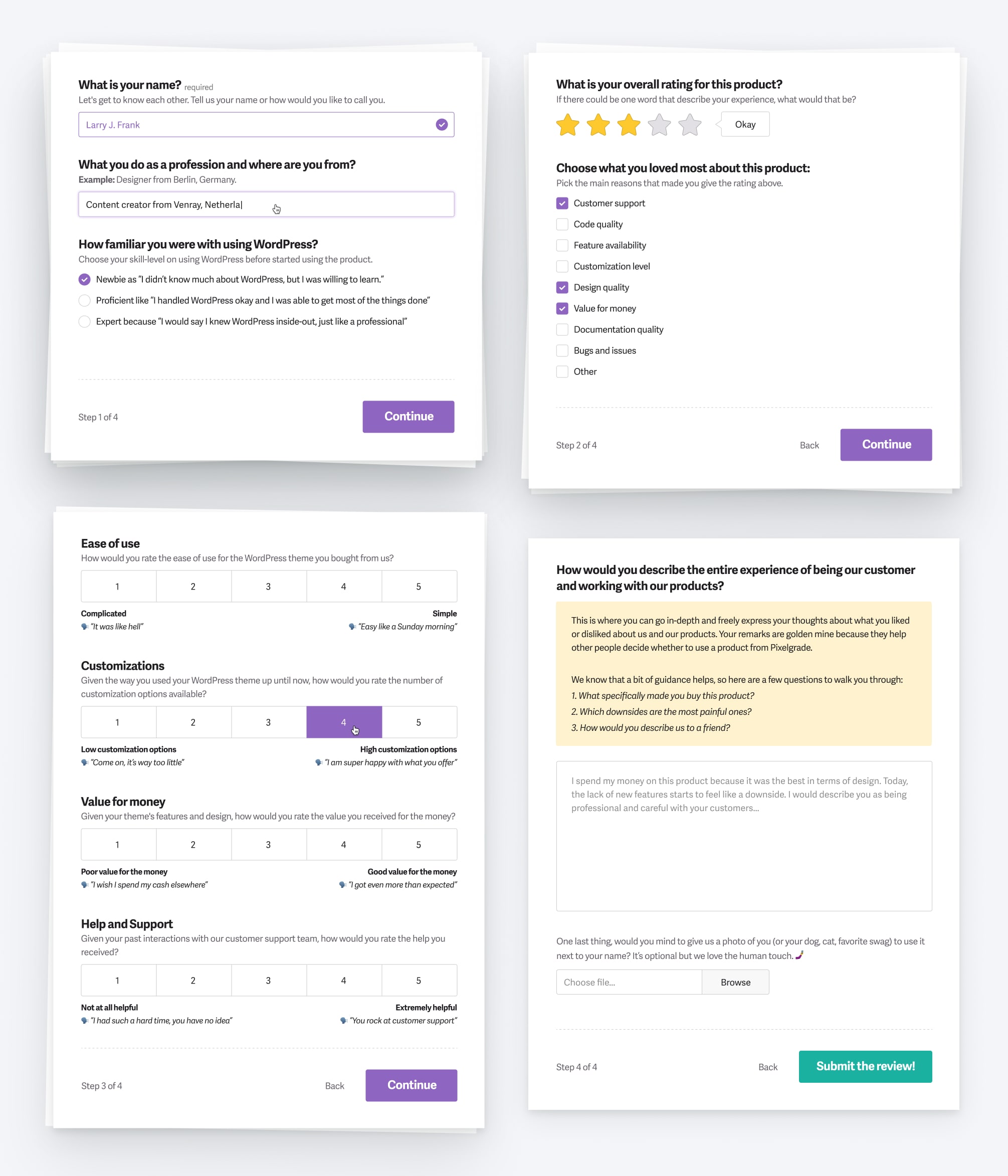
When is the best time to ask your customers to write a review?
It might sound stupid or way too obvious, but here’s the thing: to get something, you need to ask first. You might be surprised to see how many times people don’t clearly state what they want, but act like the other one should have known and behaved accordingly, regardless.
To expect people to read your mind and know your needs doesn’t apply here either. You have limited control over whether the user will write you a review or not, but there are specific signals that you can use to increase your chances.
A rule of thumb is to step in and say “Hi! How did I do?” just after the performance took place. That’s not after you sold the ticket — it’s right after the curtain falls and the show is over. That’s the moment when the experience is still fresh in the user’s mind, and you can get an honest reply.
On the other hand, too early could mean that there isn’t enough information collected for the user to have a well-formed opinion; too late, and the experience fades away while increasing the effort to remember meaningful details.
At Pixelgrade, we prompt for a review after the customer installed a product update and whenever we manage to solve a customer support request. This means that we provided the right solution, and the client can move on.
While both tactics pull on an emotional trigger (reciprocity?), the later worked well in getting more positive reviews. It’s mainly psychological since the customer felt happy and grateful after he got the solution, and the experience makes him put together constructive messages.
The process of displaying reviews
“There is no such thing as a history of unwritten ideas. An idea kept private is as good as the one you never had,” says Sönke Ahrens. Nowadays, this belief is suitable for all kinds of information that we think gain in value if we hold them just for ourselves. In this case, we’re referring to reviews.
It’s as essential to collect reviews, as it is to show them publicly. Otherwise, all the efforts are in vain; so is your chance to improve whatever you are doing.
Where to showcase customer reviews?
Considering that over 80% of consumers read online reviews before making a decision, it’s worthwhile to invest your efforts in displaying and spreading the word about them.
The most obvious place is the product page, where you should show a list of all the reviews that you have available. After that, you can feature them on your homepage, and occasionally share those that make you proud on social media.
However, the less obvious way to leverage reviews is by sharing them inside your team. We’ve learned that they are useful because they allow for small moments of celebration and boost morale. Give it a try!
How to display customer reviews in a way that builds trust?
Too often, the “form follows function” paradigm stops at the former, probably going towards another famous quote about “less is more.” In this case, it is not desirable. That’s why way too many reviews look right at a glance but lack the substance to make them truly believable.
Less is more, but, when it comes to reviews, we recommend you go with the “function.”
The most apparent cases are those 5-stars reviews you might have come across, full of appraisals and enthusiasm, but that leave out the author’s name or any external references like the review date, customer photo and location, and so on — anything that could make them real.
I’m not saying all of them are “fake,” although most are, just that they lack the minimum level of cues to let the reader build some trust.
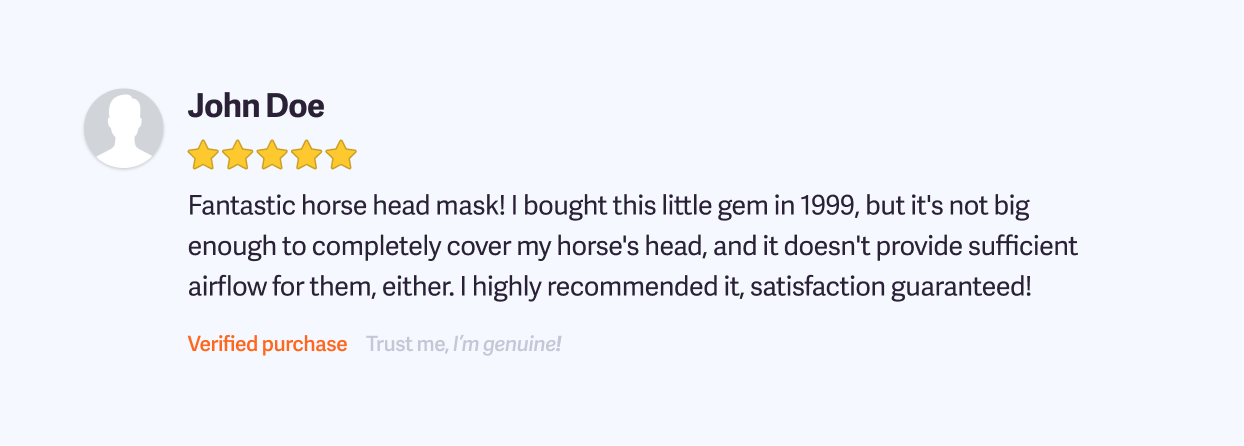
We know that you’re way above that level, but it’s useful to set a baseline and see how far you can go from here.
How can you do better? Considering that you asked the right questions at the start of this process, you now have enough information that you can use to showcase an authentic opinion.
“Intuitively, most people do not expect much from simple ideas. They rather assume that impressive results must have equally impressively complicated means.
The contemporaries of Henry Ford did not understand why something as simple as the conveyor belt should be that revolutionary. What difference does it make to let the cars move from worker to worker instead of letting the workers walk from car to car? I would not be surprised if some of them even thought of Ford as a bit simpleminded and overly enthusiastic about a rather minor change in work organization.
It is only in hindsight that the scale of the advantages of this small tweak became obvious to everyone.”
Sönke Ahrens about the Niklas Luhmann’s “secret”
Your main goal is to display the gathered information within a cohesive layout and easy-to-read manner. We argue that you need a pixel-perfect visual system before putting your reviews online.
You can use basic HTML markup, and write the content of the review manually: use pure text, emphasize the names with “bold,” and use emojis for stars or other attributes.
Linda Zadelaar, Architect from the Netherlands · April 27, 2020
⭐️⭐️⭐️⭐️⭐️ for Design
“As a visual person, I couldn’t resist Pixelgrade’s design-oriented themes. Their unique aesthetics make them really special and stand out from the crowd.”
3/5 ease of use · 5/5 value for money · 4/5 support
It gets the job done 10x more effectively than most of the review systems “enhanced” with a dynamic carousel and shadows for avatars. Sure, if you have the resources to go further, you can add some enhancements to better match your site’s branding. But before you think about a search or filtering system, make sure to add all the pieces of information that you have captured earlier, and it’s good enough.
What’s the anatomy of a review?
Now that you have the foundation of your reviews in place, you can dive into shaping their visual design.
Hopefully, over time, you will collect more than a handful of reviews, each of them showing a slightly different, but valuable, perspective about your work. The downside is that this quickly transforms into information overload and makes it harder for people to grasp.
The solution that we propose aims to add a little bit more hierarchy and emphasis to the main elements (e.g., author, rating) while reducing the visibility of the ones less significant (e.g., date). This will help the user quickly scan the list of reviews, find the details that they are interested in, and extract the necessary data to decide whether to buy your service or product right away, or wait a little more.
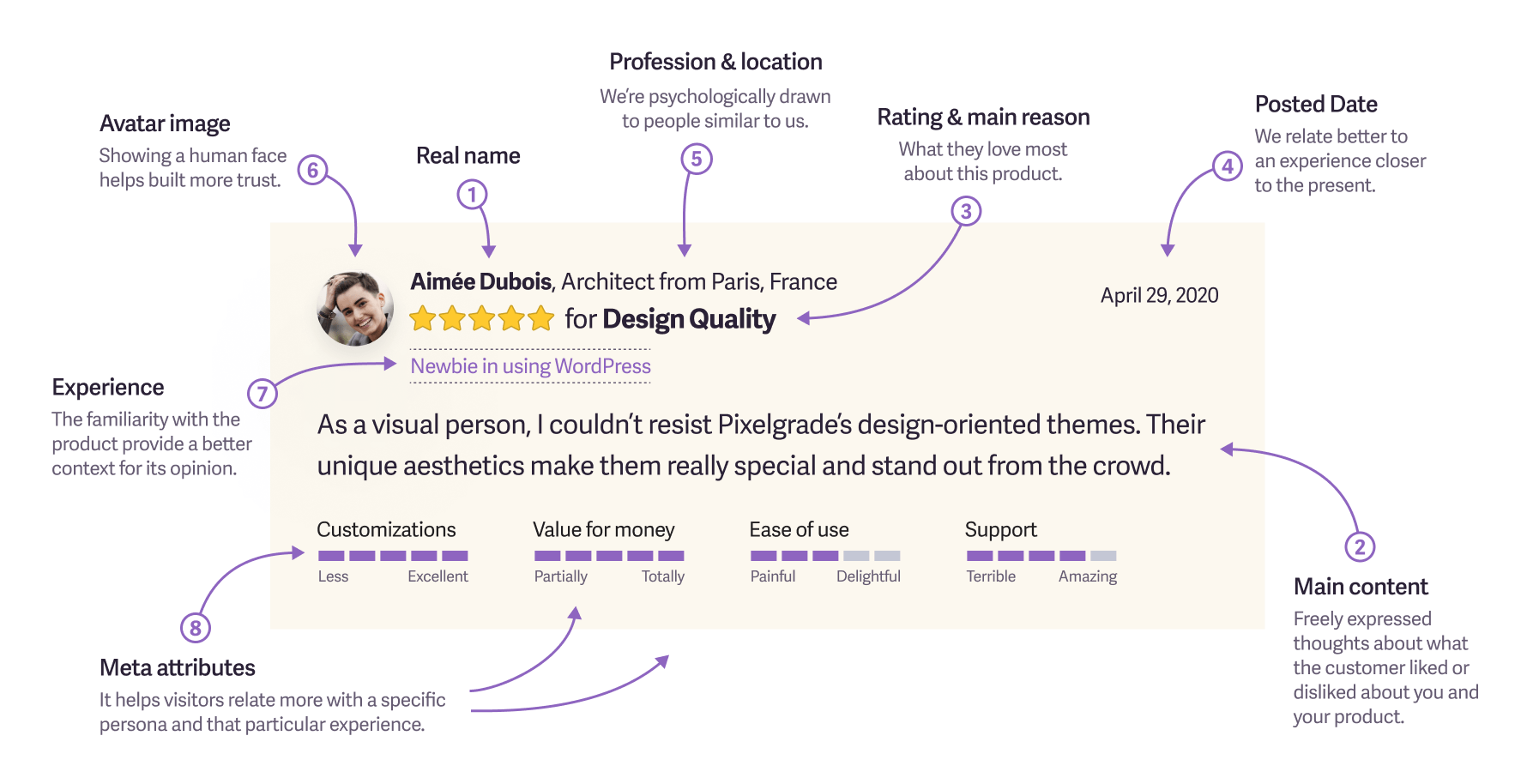
You might notice that we display quite a handful of data (over 10 items for each review). We choose to have this level of detail because we believe people are complex, and, naturally, customers and the way they use a product or service are guaranteed to be even more so.
To be able to relate to another person and their experience, you need to know a little bit about them and, hopefully, you will glimpse something meaningful to you before making a decision (e.g., value for money). Therefore, seeing the profession could be more important than the actual name — unless it’s Natalie Portman; then, nothing else matters.
Ground rules for a review system
Here’s the thing: employ such a system if you are genuinely ready to accept both the good and the bad (criticism included) and are eager to do something with all the information you capture. Without this attitude, you are just playing around and wasting precious time and resources.
We’re all messing it up sometimes in real life, and we don’t have a “Delete” button to cover it up.
So, with that in mind, we’ve drafted a couple of simple, yet efficient, rules for you to follow. Frequently, we miss them because we are high on the promise of what these reviews could do for our sales. However, as is the case with relationships, we need to be honest and accept the whole dynamic, regardless of how it evolves over time. We don’t pretend we don’t see what we don’t like, nor do we overemphasize what suits us better.
1. Publish everything
Needless to say that none of us is perfect, even if we all, sometimes unconsciously, strive to portray an ideal image onto others. No matter the number of stars or type of feedback, you have a moral obligation to publish them as-they-are and make them available to interested people. Hiding critical reviews from your website does nothing else than escalate customer frustrations and channel their voice to other places (e.g., personal blogs, social media), places where you lack any control whatsoever.
2. Be honest about it
Create a policy page (or moderation guideline) with the rules upon which you will accept or discard submitted reviews. For instance, you may allow reviews only from people who actually used your product, thus keeping self-promo messages at bay. Moreover, you may not agree with any inflammatory language or harassment.
As long as you set these expectations from the start and make them available, you are covered and get the chance to start on the right footing.

If you want an example of a “Review Moderation Policy”, here is our short and straightforward one.
3. Respond to reviews
It’s part of the promise to get back to people who have written a review and reply to them. It is also an opportunity to reinforce some of your values and beliefs. In the end, it’s a two-way street.
For us, it implies showing gratitude to the people who took their time to write a review and taking responsibility by responding to all of them, especially to the bad ones. We don’t sugarcoat anything, and we undertake the whole process.
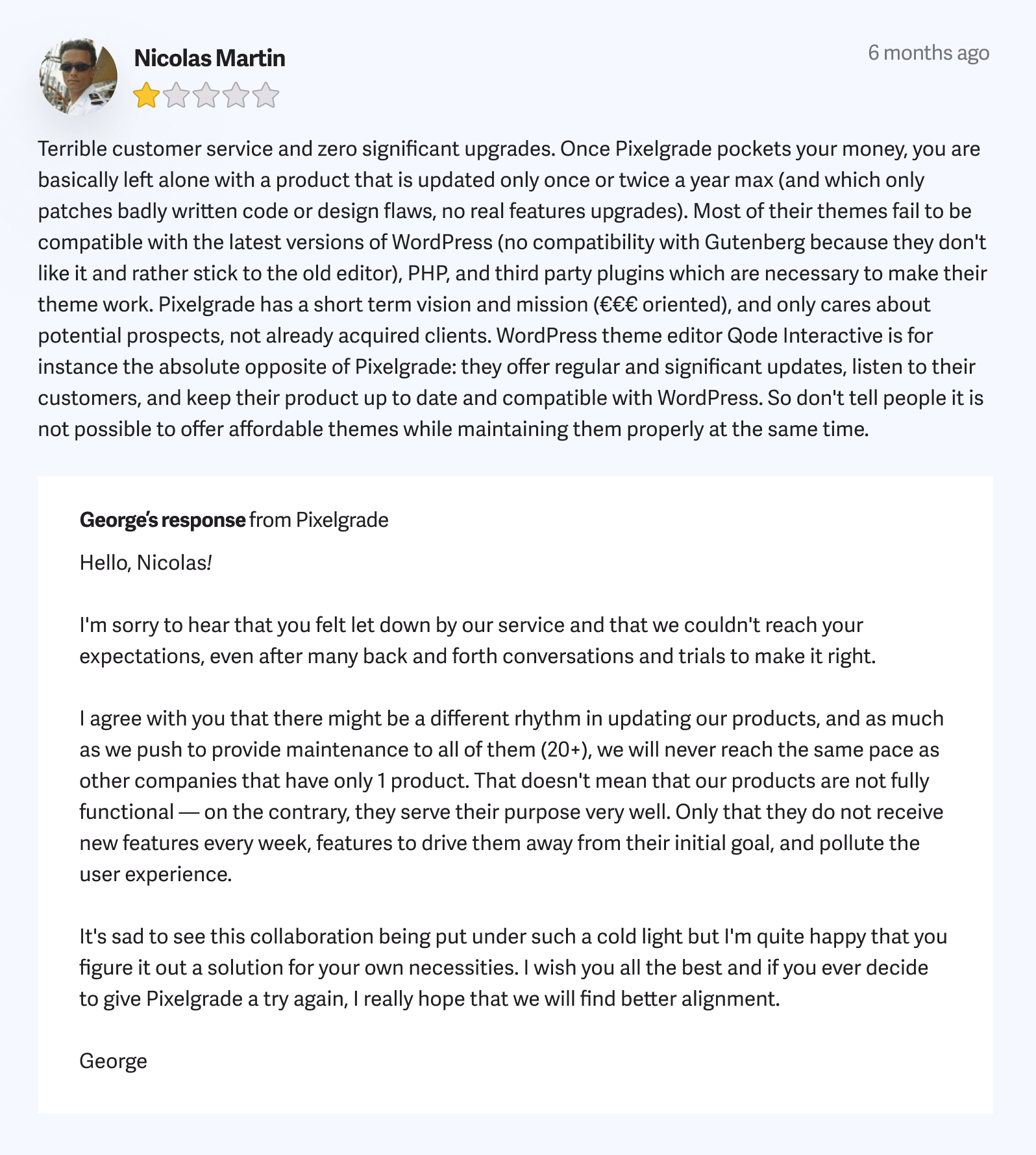
4. Pack insights into actions
Gathering information for the sake of it it’s just a waste of time. We, too, were in the scenario of capturing data with the hope that it will shed light on what to do next. However, most of the time, it just brought a lot of pressure and suppressed our gut instincts.
We try to keep an open mind toward the reviews we are receiving and take specific actions that make us and our work better. It can be an update for a product, some fine-tuning of the microcopy on our website, or it can be a different approach in customer support.
Customer reviews require constant work
Relationships are complicated. Today, even more so than ever. Still, they are not impossible, nor are they a reason to drain yourself of energy and emotions. However, they require involvement, frankness, kindness, and a lot of active listening.
The same applies when you are creating bonds with your customers. If you want relationships, not purchases, if you aim to create a playground where both of you learn and help each other, if you understand that today the most meaningful liaisons are the ones based on values, you need to level up the game.
“By some mysterious mental mechanism, people fail to realize that the main thing you learn from a professor is how to be a professor and similar to an inspirational speaker or life coach. “
Nassim Taleb, Skin in the Game
Now it’s your turn! We encourage you to show up and start your journey. We might have given you a few helpful pointers to up your chances of reaching your destination, but it’s your adventure. You alone will have to discover, and overcome, its unique challenges, while, at the same time, you are far better suited to build upon its unique advantages. We’re confident you are going to make it happen!
We have the same thorough approach when building WordPress themes. Browse our portfolio and see if something catches your eye.
Start the conversation